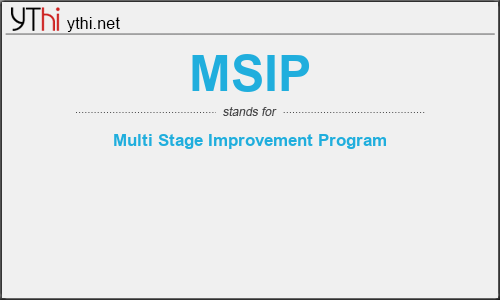What does MSIP mean? What is the full form of MSIP?
The Full Form of MSIP is Multi Stage Improvement Program.
The Multi-Stage Improvement Program (MSIP) is a joint program carried out by McDonnell Douglas and the USAF’s Warner Robins Logistics Center in Georgia. Under MSIP, upgrades were progressively incorporated onto the production line and then retrofitted to earlier production aircraft.
MSIP II is that portion of the program which handles the F-15C/D. The major part of MSIP II is to fit the APG-70 radar and the AIM-120 AMRAAM.
The Electronic Warfare Warning Set (EWWS) was modified into the more capable Tactical Electronic Warfare System (TEWS) with an ALQ-135 electronic countermeasures set and an upgraded ALR-56C radar warning receiver. An overload warning system was provided to prevent pilots from accidentally exceeding 9g during combat maneuvering.
The F-15C/D aircraft going through the MSIP II were fitted with the wiring needed to give them the capability of carrying and launching the AIM-120 AMRAAM missile, which was introduced into service in the early 1990s.
Another part of the MSIP II was the Seek Talk program, which was designed to reduce the vulnerability of the F-15’s UHF radios to enemy jamming by introducing spread spectrum techniques and the use of a null steering antenna. Yet another was the Joint Tactical Information Distribution System (JTIDS), which is intended to provide high-capacity, reliable, and jam-proof information distribution between various elements of deployed forces and command and control centers. Another aspect of the MSIP is the integration of the F-15 with the Global Positioning Satellite (GPS). A new multi-function display armament control panel was introduced. New stick-top and throttle grips were added. The ECM equipment was improved, with ALR-56C RWR, ALQ-135B internal ECM system, and enhanced ALQ-128 being introduced.
The major part of MSIP II involved the development an upgraded AN/APG-63 radar, which is so much improved that is given the new designation of AN/APG-70. In this unit, the radar data processor memory was increased from 16K to 24K, and its processing speed was increased by a factor of three. The memory capability of the APG-63 radar fire control system was increased from 96K to 1000K and the processing speed was trebled. A Programmable Armament Control Set (PACS) was installed. The new unit has multiple bandwidths for high-resolution ground mapping using SAR technology. Several new radar modes were added, such as track-while-scan, which made it possible to ripple-fire up to four BVR missiles at separate targets simultaneously. The APG-70 radar also had a Low Probability of Intercept (LPI) capability, which makes it possible for it to detect and direct attacks on enemy aircraft without its emissions being easily seen by the enemy. The new processing power made available with the use of the new APG-70 radar made it practical to make use of Non-Cooperative Target Recognition (NCTR) technology, which provides the ability to distinguish more reliably between friendly and hostile aircraft. Much of the NCTR technology is highly “black” and very few details are available, but it reportedly makes it possible to avoid a lot of “friendly fire” accidents, such as the one that resulted in the loss of the IranAir Airbus in July of 1988.
The first MSIP II aircraft was F-15C 84-001, first flown on June 20, 1985. MSIP II was still underway at the time of the Persian Gulf war of 1991, and the AIM-120 AMRAAM was not yet ready for combat use. However, MSIP II F-15Cs were quickly despatched to the Gulf, and during the war they achieved an impressive kill ratio against Iraqi aircraft. The NCTR system was supposedly so good that it was able to identify aircraft by model and even by subvariant. There were no “friendly fire” incidents during the Gulf War, although there was a tragic incident after the war in which a couple of United Nations UH-60s were shot down, which indicates that the system is still not perfect.
It was orginally planned that almost all F-15A, B, C, and D versions were to go through the MSIP program. The A/B models that went through the MSIP were not to be fitted with the conformal fuel tanks of the C, but they were to be otherwise indistinguishable from the C. However, plans to include the F-15A/B in this program were abandoned as being too costly. Some of the very early As (from FY 1973, 1974, and 1975) were retired and made available as gate guards or were donated to museums. Others were retired to AMARC. Some of them were given to Israel as payment for policy decisions made during the Gulf War.
MSIP
means
Multi Stage Improvement Program![]()
Translate Multi Stage Improvement Program to other language.


Leave a Reply
You must be logged in to post a comment.